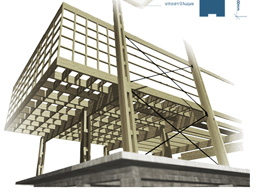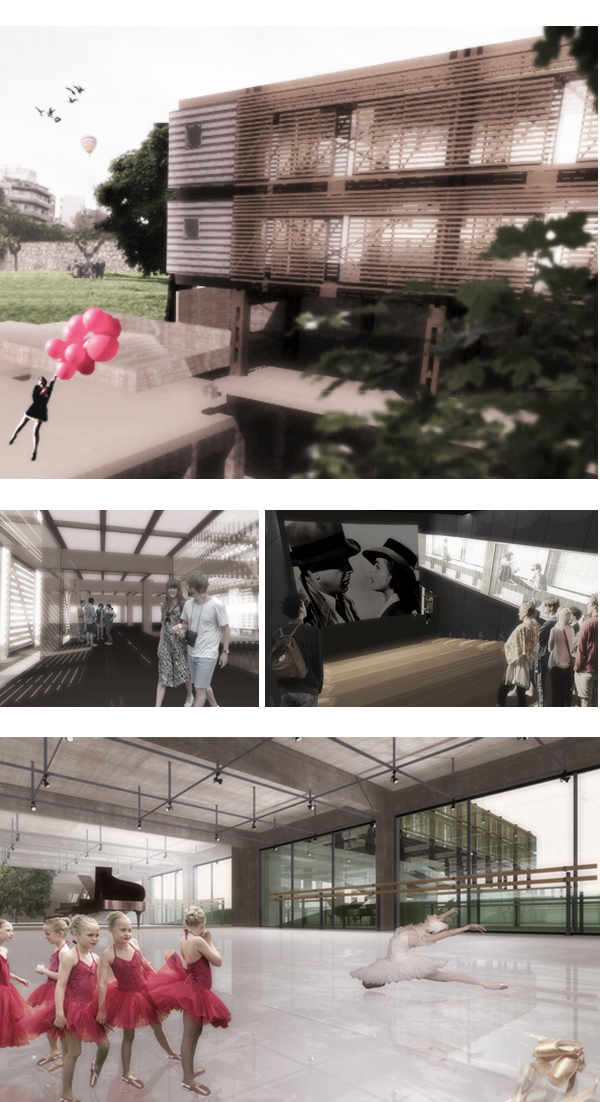STUDENTS PROJECTS
PROJECTS2012

20 September, 2013
Artistic high school near the House for the Elderly in Athens
The artistic culture in second degree education.
Student: Anditsopoulou Nafsika
Teacher: M.Kafritsa
Advisors: V.Tsouras, M.Manios
N.T.U.A School of Architecture
Presentation date: November 2012
The diploma project consists of the design of an artistic high school near the House for the Elderly in Athens. Artistic schools differ from regular high schools because of the existence of three artistic orientations in their curriculum, namely Theater|Cinema, Graphic Design and Dance.
The institution exists in our country since 2003 while today there are only three such schools ,one of which is in Athens, in Gerakas region, and the other two in Thessaloniki and Crete. Artistic culture in second degree education is very important for the development of the artistic skills of students but also for the formation of their occupational orientation in such areas.
The site that is chosen for the location of the school building is in Ampelokipi, near the House for the Elderly in Athens and belongs to the Organization of School Buildings (0.S.K.)
This specific location serves the lyperlocal identity of the school while at the same time offers fast an easy access to places of interest, and protects from the nuisance of the central roadways that surround the site.
More specificly, the visitations of museums, galleries and places of artistic interest in general are facilitated to serve the purpose of the artistic curriculum.
The access to the area of the site is supported by a developed network of public transportation (metro stations Panormou, Ampelokipi, Katehaki, busies and trolley). This fact serves the access to the site for the students and teachers as well as for anyone who is interested in coming to the school to watch the events that may be taking place during afternoon hours.
The site belongs until 2003 to P.B.E. (Public Business of Electricity) but after activation of the citizens it goes under the ownership of O.S.K. and this is when it is converted to a site for the erection of a school building.

The school building accommodates all six classes of second degree education, so that students of different ages understand the environment of this special community, through their working together in teams.
At the same time this smooth transition from the three first classes to the next helps students choose their orientation and hopefully the field of their studies in third degree education.

Basic parameter of the central idea is the design of a combined construction that consists of reinforced concrete and timber. Namely, due to the large height differences of the site, the building includes ground spaces and also semi-underground spaces that are shaped as concrete constructions, while all the levels above the ground are materialized with an extensive 2-floor timber construction.
A very important element of the design is the division of the functional sections of the building according to this constructional idea. In the first category, that includes the basic ground floor with the school entrance, one finds the more "public" artistic spaces , those that refer to all the students as well as to the neighborhood during afternoon hours. The visitors are first led to a central foyer through two entrances from different parts of the neighborhood and are then distributed to the artistic spaces , namely the two dance halls, the cinema, the theater, and the studios of graphic design and visual arts.
In the contrary the timber construction that is developed in two floors, includes two by two the "private" spaces of the classrooms of basic curriculum teaching.

So that the theater is in the center of school everyday life, it is designed in such a way, that enables it to adjust to the needs of different artistic activities that take place in it, so that it can be used as a theater as well as a dance hall. This is accomplished through a system of electric square platforms that scans the entire hall, with the simultaneous use of a folding, moveable seating system.
Every one of these platforms can be adjusted to various heights, so that they enable the differentiation of the space of the scene in size and shape as well as the change of its place in the theater, while the seats can be arranged in various typical theater set-ups or can be folded to leave the entire hall free.

The timber construction, that includes the classrooms, can be analyzed in three categories of bearing members. The primary bearing member is formed with compound timber columns 450mmX400mm and timber beams 150mmx550mm as a frame that repeats itself in a frequency of 6,6m/6,6m/4,4m.
The secondary bearing members are beams 120mmx400mm while the tertiary that also accommodate the floor construction consist of beams 90mmx250mm, which are placed in an axial distance of 660m.
In the direction of the main bearing frames, the inflexibility of the construction is accomplished by the main truss beam while at the other direction with metal wind bracings that are placed in the northern and southern fassade.
The shading of the southern fassade is accomplished with a system of electrical wooden louvered panels that allow the control of the shading of the space in front of the classrooms.

Related articles:
- Music high-school in Plato’s Academy ( 23 June, 2009 )
- ARSAKEIO OF TIRANA GREEKALBANIAN SCHOOL ( 23 June, 2010 )
- ARSAKEIO OF PATRAS ( 15 October, 2009 )
- School of architecture Patra ( 23 July, 2010 )
- Education for production_ School of industrial design engineering on Iera Odos ( 08 April, 2011 )
- Μodel Εducational Unit in Kozani ( 31 January, 2011 )
- Student Residence in Lofos Sikelias Neighborhood ( 02 March, 2011 )
- Experimental educational complex in Tagarades, Thessaloniki ( 03 March, 2011 )
- Independence Spaces - Hazelwood School Glasgow ( 01 May, 2011 )
- Tellus Nursery School ( 29 December, 2013 )
- Pio Baroja Nursery, learning from playing ( 07 June, 2014 )
- School center in Ambelokipi (High School - Μidle School) ( 20 March, 2012 )
- Concrete production plant reformation ( 05 April, 2012 )
- Primary school ZV Zavelput ( 14 April, 2012 )
- International architectural competition. Innovative, bioclimatic, European school complexin Crete, Greece ( 03 February, 2013 )
- Nest and flight ( 18 April, 2013 )
- Dance and Music Art Center (DaMAC) in Klafthmonos Square ( 07 July, 2013 )
- Diffuse school in the urban tissue of Patras ( 20 April, 2014 )
- Towards a social school ( 11 November, 2014 )
- Greek High-School, Laniteion ( 17 March, 2015 )
- An alternative music academy ( 25 March, 2015 )










